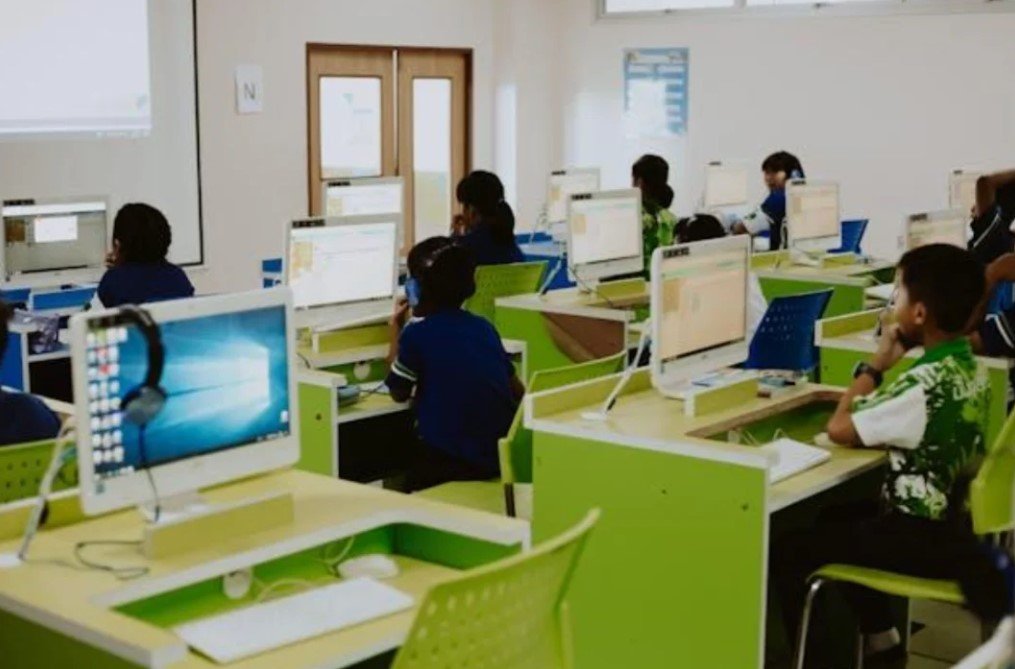Education
Touch, Tap, Learn: Bringing Classrooms to Life with Interactive Displays

You know the struggle. You pour yourself into each and every lesson, yet reaching every student feels like pushing a colossal rock uphill.
Decrepit projectors cast near-unrecognizable images. Static presentations bore students before you’re finished with the first slide. Bulky TV carts hog space and gather dust. Eyes glaze over. Fingers tap desks. The disconnect is real: it drains you and frustrates students who crave interaction.
You need tools that match the vibrant, dynamic world students live in outside your walls. Enter the interactive classroom. It solves the problems you and your students battle everyday. Finding the right AV solution to build a successful interactive classroom helps you stop competing for their attention and start commanding it.
Let’s break down exactly how:
Passive Learning Leads to Disengagement
Students tune out when they only watch or listen. They need to do. It may feel counterintuitive to teachers raised on doing just one thing at a time, but get past that little mental hurdle and you’ll be pleasantly surprised with students eager—starving, even—to learn: the very same kind of students you dreamed of teaching when you were in school!
It seems paradoxical, but it works. How? Interactive displays invite touch. Students physically interact with content. They manipulate digital objects. They solve problems directly on the surface.
Think of a geography lesson. Instead of pointing at a static map on a projector, students drag country names to their correct locations on the giant display. They pinch-zoom into river deltas. They draw trade routes with their fingers. The display becomes the focal point for hands-on exploration. Suddenly, abstract concepts gain physical dimension.
This active manipulation triggers deeper cognitive processing. Students remember more because they did more. It transforms spectators into participants. Every touch reinforces learning.
Interactive displays might feel like toys, especially to older teachers. Maybe even distractions. That can be true, too. That’s why it’s essential to remember that focus dictates outcome. That means you can’t rely on screens alone. You need to structure activities with clear learning objectives. Use the interactivity purposefully. Guide students toward specific manipulations that illuminate the lesson’s core concepts.
Collaboration Feels Clunky and Limited
Group work often means huddling around a small laptop or passing a single marker. Only one or two students truly engage at a time. Others disengage, drifting farther and farther away…
Modern interactive displays prevent this. Because they can handle multiple touch points all at once, several students can work on them simultaneously. That opens up the possibility for collaboration that’s both cohesive and inclusive.
Imagine a science lab planning session. Four students stand at the display. One drags images of lab equipment onto the workspace. Another writes the hypothesis directly on the screen. A third annotates the safety procedure steps. The fourth connects their ideas with digital arrows. Everyone contributes visibly, in real-time.
Brainstorming flows organically. Shy students find it easier to add a digital note than speak up immediately. The display becomes a dynamic shared workspace, making collaboration tangible and equitable.
Classroom too small? No problem. You control the flow. Use a mix: whole-class collaboration at the display for synthesis, paired work at desks for deeper dives, individual reflection using companion apps that connect to the display. Rotate student groups to the front for specific tasks. The display anchors collaborative moments; it doesn’t demand constant crowd immersion.
Rigid Resources Limit Teaching Flexibility
Switching between a document camera, a laptop presentation, a video, and a website feels like a juggling act. It breaks momentum. Precious minutes vanish in technical transitions.
Interactive displays unify your digital toolkit. Everything integrates into one powerful hub. Display a student’s answers to math problems solving in real-time, zooming in on steps they may have missed. Switch to your laptop to show a simulation of solar eclipses. Pull up a historical document online and underline important passages as you read. Load up a video, pausing every so often to highlight important details or to provide context. The display handles it all within one interface.
No more fumbling with cords or input switches mid-lesson. This fluidity keeps students focused on the content, not the technology. You maintain instructional flow effortlessly. Think of transitioning from analyzing a historical photo under the doc cam to instantly overlaying a related timeline stored on your cloud drive, drawing connections between events right there on the image. The connection becomes visceral.
Reaching Diverse Learners Requires Constant Adaptation
Catering to different learning styles with tools that can’t be adapted is hard, if not downright impossible. Visual, kinesthetic, and auditory learners don’t learn at the same level, no matter what you do. Interactive displays give you the freedom to cater to different learning styles without creating separate lesson frameworks. You get to adapt seamlessly, and your students reap the benefits.
The large, bright screen inherently benefits visual learners. Integrated audio and text-to-speak features hold auditory learners captive (in a good way). Obviously, kinesthetic learners will have a blast with all the interactive possibilities.
One common concern from teachers here is the potential for an even heavier workload than they already have. But if you can work on a tablet—and you definitely can—you can work with this. Focus on starting small, building confidence. The time saved from juggling devices and regained from heightened engagement quickly offsets the initial learning curve.
Static Presentations Lack Dynamism and Spontaneity
Pre-made slides lock you into a sequence. Capturing teachable moments or student questions that require visual explanation feels impossible without disrupting the flow.
Interactive displays empower real-time creation and adaptation. Start with a blank canvas. Build the lesson live with student input. Import an image or diagram and annotate over it spontaneously as questions arise. Freeze a video frame and draw on it to illustrate a concept. Pull up a web resource instantly because a student asked a brilliant tangential question. Save these spontaneous annotations directly onto the displayed material for future reference.
This flexibility transforms the display into a dynamic thinking space. It allows you to follow the natural curiosity of the class without losing structure. Your teaching becomes more responsive and alive.
The Workflow Win: Beyond the Flash
Students clearly benefit from interactive displays. The question you might be afraid to ask is how, exactly, they benefit you. No need to fear: interactive displays make your life easier!
For instance, it might be a struggle annotating digital worksheets directly on the displays with the class. But you can save those annotations for next time, freeing you up from the drudgery or writing the same comments over and over. School administrators will also love skipping on printing costs!
Split-screen functions also help you compare texts easily, saving you from going cross-eyed and reducing the neck strain that comes from constantly whipping your head side to side with paper texts.
You can also use interactive displays to show visual timers or daily agendas, instead of holding all that data in your head and regurgitating them each time a student asks you about them.
And that’s not all. The more you work with interactive displays, the more uses you’ll find for them!
Wrapping Up
Interactive displays solve fundamental classroom challenges leaders face: passive learning, limited collaboration, resource juggling, differentiation difficulties, and rigid presentation. They transform the front of your room from a passive viewing area into an active, collaborative learning engine.
This is only a sneak peek at what interactive displays can do to make your job more about what you love—teaching—and less about all the other stuff that distracts you from it. Integrate them in your classroom today and you’ll surely find other ways they can reignite your passion for teaching!
-

 Social Media2 months ago
Social Media2 months agoWhat the “67” TikTok Meme Really Means
-

 Tech2 months ago
Tech2 months agoWhat To Do When Your Business Faces Network Vulnerabilities
-

 Self Improvement2 months ago
Self Improvement2 months agoUsing BCBS Rehab to Access Quality Addiction Care
-

 Games2 months ago
Games2 months agoPusoy Strategies for Play That Also Work in Pusoy Dos in English






